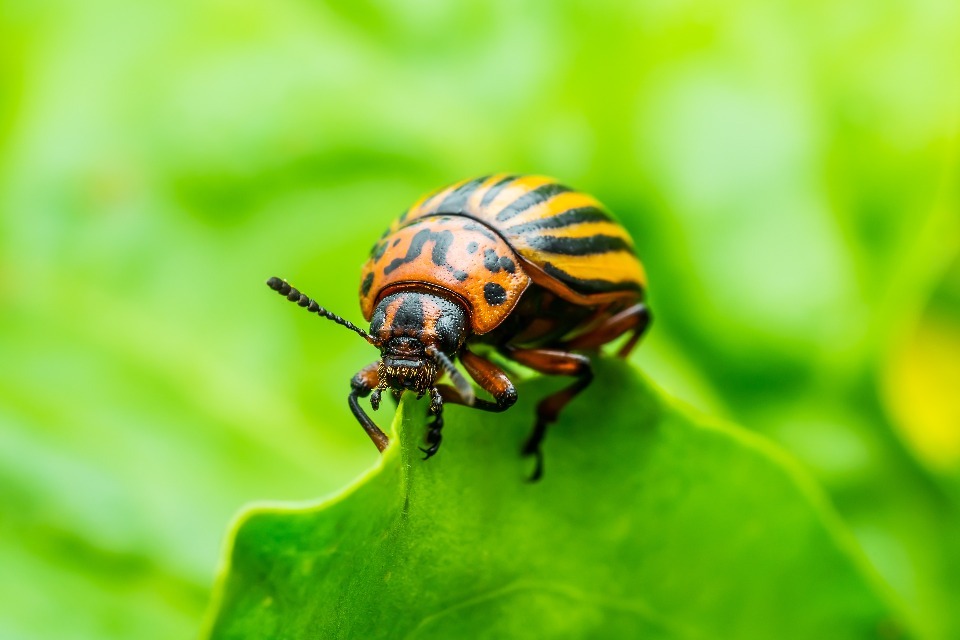Home gardeners, allotmenteers and farmers have been urged today (Monday 19 May) to be vigilant for the presence of Colorado beetle, a major threat to potato crops, following recent sightings.
The Colorado beetle has the potential to have a significant economic impact on the potato industry without action being taken. Adult beetles and larvae feed on the foliage of potatoes and several other plants, including tomatoes, aubergines and peppers, and can completely strip them of their leaves if they are left uncontrolled.
Colorado beetle larvae were confirmed in a potato field in Kent following laboratory diagnosis of samples in 2023. There were outbreaks in the 1930s, 1950s and 1970s but the pest was swiftly eradicated due to inspections and public vigilance.
The beetles have been known to be imported into the UK as ‘hitchhikers’ on plants, such as leafy vegetables, salad leaves, fresh herbs, grain and frozen vegetables, and APHA is urging people to keep an eye out when handling these items.
Professor Nicola Spence, Defra’s Chief Plant Health Officer, said
“The Colorado beetle poses a significant threat to plants and the wider potato industry.
“The public have an important role to play in helping us take swift and effective action to protect UK biosecurity. The public are urged to be vigilant and report suspected sightings to the Animal and Plant Health Agency with a photo and location details.”
APHA Interim Chief Executive Dr Jenny Stewart said
“Public vigilance was key to eradicating the beetle in the 1970s, and we really need home gardeners, allotmenteers and farmers to step up again, and identify and report suspected sightings to protect potato crops.
“Our surveillance capabilities protect UK borders from a wide range of plant pests and diseases, including the Colorado beetle, but we cannot do this without the help of the public.”
How to spot a Colorado beetle
- The beetle’s body is yellow or cream with 10 black stripes and it has an orange head with irregular black spots.
- It is usually between 6 to 11mm in length and 3mm in width. Its larvae are a pinkish red or orange colour, with black spots along each side and a black head and are up to 15mm in length.
- They are distinctive in appearance, however, there are several beetles that are frequently mistaken for them.
APHA is exhibiting at this year’s RHS Chelsea Flower Show to raise awareness of the impact this pest can have on UK food security and the potato industry
Visitors to APHA’s Chelsea Flower Show exhibit can engage with interactive graphics and a multimedia experience highlighting how the beetle attacks plants and how to identify signs of the pest.
The exhibit (location GPA004) will also showcase how to report suspected findings to APHA in an effort to protect the British potato industry.
Additional information
- If you find a Colorado beetle in England and Wales, please do not let it go – capture it in a secure container and report any suspected sightings to APHA as soon as possible by telephoning 0300 1000 313 or by emailing the planthealth.info@apha.gov.uk mailbox. All sightings should include a photograph and location details.
- For Scotland, contact the Scottish Government’s Horticulture and Marketing Unit Agricultural crops contact the local RPID officer http//www.gov.scot/Topics/farmingrural/Agriculture/AOcontacts/contacts For non-agricultural crops, email hort.marketing@gov.scot
- For Northern Ireland, contact the DAERA Plant Health Inspection Branch Tel 0300 200 7847 Email planthealth@daera-ni.gov.uk Web [https//www.daera-ni.gov.uk/topics/plant-and-tree-health]
- The Colorado beetle does not represent a risk to human health.
- The Colorado potato beetle plant pest factsheet provides more information about the beetle’s life cycle and provides information on how to differentiate it from some of our native beetle species.

